There are many ways to Trading in the Stock Market, but one of them is Call Option Trading. Although the concept of option trading may seem a little complicated at first, understanding its basics will make your trading journey easier and help increase your investment potential significantly .
Through this blog we are going to give a complete idea about what is Call Option Trading, how it works in trading and also its Potential Benefits and Risks which will make your Trading Journey stronger.
What is a call option?
A Call Option is a contract between a buyer and a seller that gives the buyer the right, but not the obligation, to purchase an underlying asset (Such as Stocks, Currencies, or Commodities) at a specified price (known as the strike price) up until a defined expiration date.
What is a Call Option in the Stock Market?
In the stock market, a call option is a type of option contract specifically tied to the underlying asset of a company. Call options can be bought or sold in the options market.
How do Call Options work?
When an investor buys a Call Option, they are speculating that the price of the Underlying Asset will rise above the strike price before the Option expires.If the Underlying asset’s price exceeds the Strike Price, the investor can exercise the Option, buy the asset at the lower strike price, and potentially sell it at the higher market price for a profit.
If the asset’s price does not exceed the Strike Price before expiration, the Option will expire worthless, and the investor will lose only the premium paid for the option.
Conversely, When an investor sells a Call Option, they expect the asset’s price to stay below the strike price.
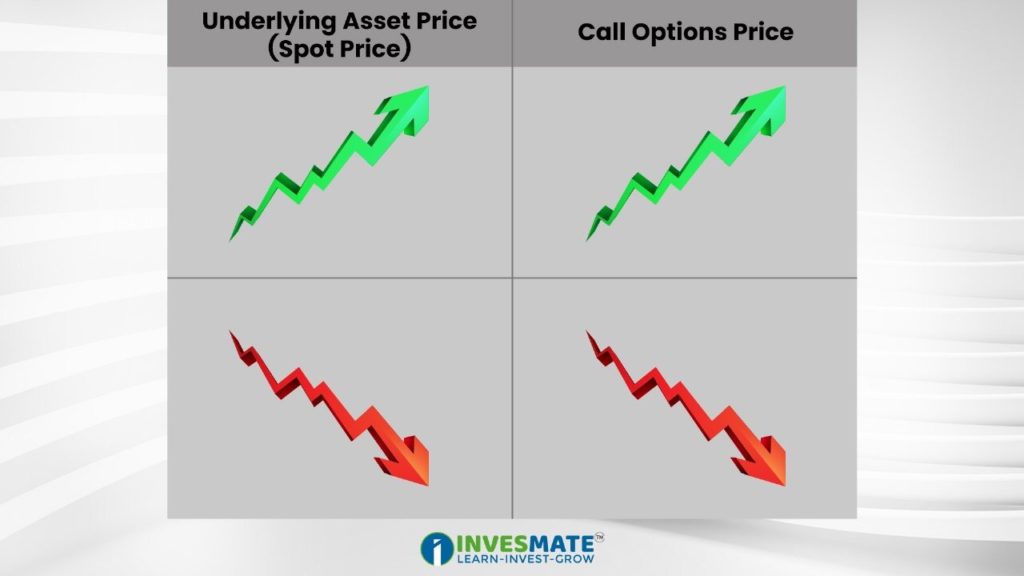
Read Now : The Beginner’s Guide to Options Trading
Call Option Example :
There are Two Types of Trading in Call Option: Call Option Buying and Call Option Selling.
Scenario 1
Buying a Call Option
When we buy a call option, we acquire the right to buy the underlying asset at the strike price at any time before the option expires. We pay a premium to the seller for this right.
Example on Call Option Buying
Below is an example for easy understanding of Call Option Buying.
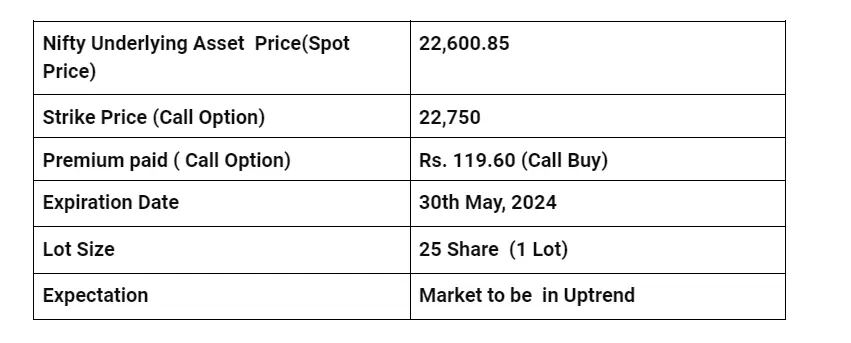
Spot Price, Strike Price, Premium, Expiration Date Explained The Beginner’s Guide to Options Trading.
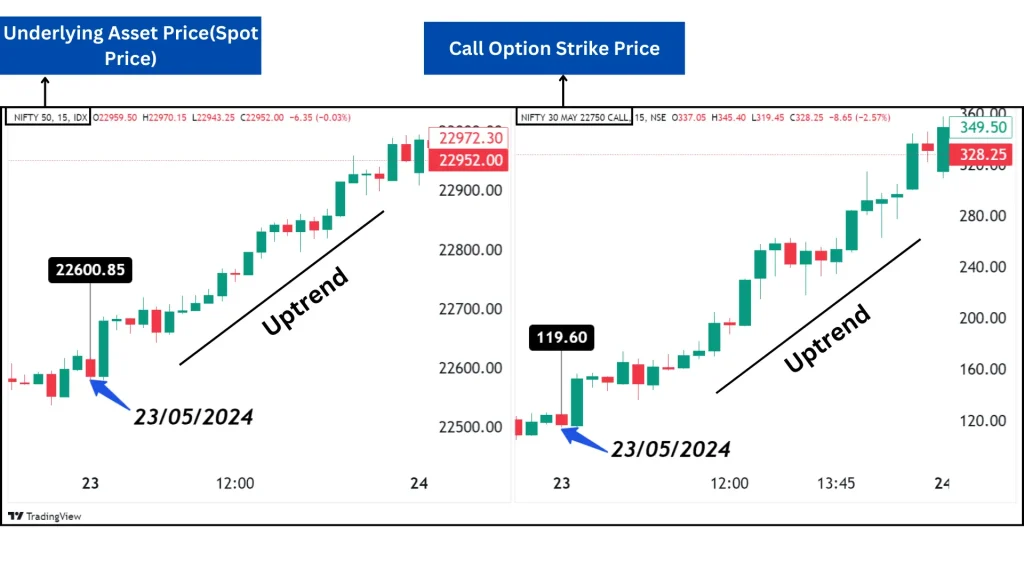
Assume you are predicting a rise in the Nifty Index price, so you have to buy a Call option.
We have chosen the Nifty-50 index. On May 23rd, 2024, the Nifty’s underlying asset price (Spot Price) was 22,600.85. Taking in consideration the Nifty Call Option with a strike price of 22,750 was priced at 119.60. The expiration date for this option is 30th May, 2024. When the Nifty’s Underlying Price (Spot Price) rose to 22,952, the Call Option price increased to 328.25.
Potential Outcomes :
The premium of the call option has increased by Rs. 328.25. If we had bought the call option at Rs. 119.60, then by selling the option, we would have booked a profit of +5,216.25.
Profit & Loss Calculated =(Current Premium -Premium Paid) x Lot size
=(328.25 – 119.60) x 25=208.65 x 25
=208.65 x 25 (1 Lot) = +5,216.25
But one thing to remember is that if the Nifty Underlying Asset Price (Spot Price) is below 22,600.85 or falls, we will lose the Premium paid for the option. in this case-
ধরা যাক Expiry শেষে Nifty 22,500-তে পৌঁছেছে।
The Payoff Chart For Call Option Buy
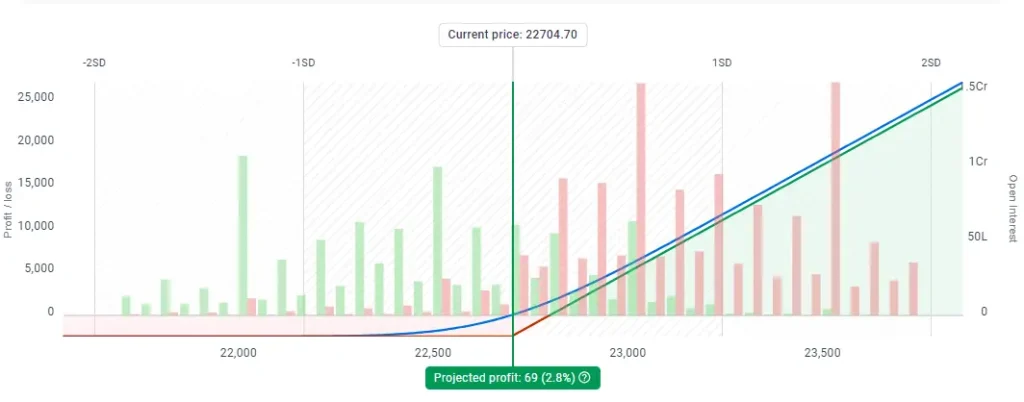
- The payoff chart for a call option buying indicates that the profit potential is unlimited, as the profit increases with the rise in the underlying asset’s price.
- The maximum loss is limited to the initial premium paid for the call option. This means that regardless of how low the underlying asset’s price falls, the most the option holder can lose is the amount paid for the option premium.
Scenario 2
Shorting a Call Option
When we sell a call option, we are the seller (also known as the writer). This is usually done when we expect the price of the underlying asset to be below the strike price, and if we already own an underlying asset, we can generate additional income from it.
Example on Call Option Selling
Below is an example for easy understanding of Call Option Selling.

* Spot Price, Strike Price, Premium, Expiration Date Explained The Beginner’s Guide to Options Trading
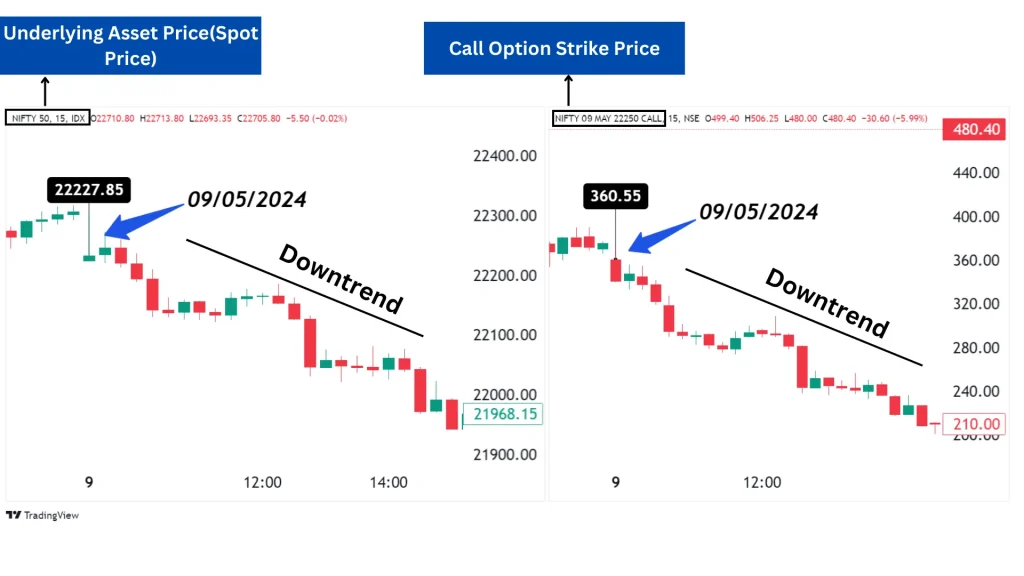
Assume you are predicting a fall in the Nifty Index price, so you have to sell a Call option.
We have chosen the Nifty index. On May 9th, 2024, the Nifty’s Underlying Asset Price (Spot Price) was 22,227.85. Taking in consideration the Nifty Call Option with a Strike Price of 22,250 was priced at 360.55. The expiration date for this Option is 9th May, 2024. When the Nifty’s Underlying Price (Spot Price) fell to 21,968.15, the Call Option Price decreased to 210.
Potential Outcomes:
The premium of the call option has decreased by 210 rupees. If we sell the call option for Rs.360.55, then by executing the option, we would have booked a profit of Rs. +3,763.75
Profit & Loss Calculated =(Premium Received – Current Premium ) x Lot size
= (360.55– 210) =150.55
=(150.55 x 25)= +3,763.75
But one thing to remember is that if the Nifty’s Underlying Asset Price (Spot Price) rises above 22,227.85 at the time of expiry, you will incur a loss on the call option., In this case-
=Let’s say Nifty reaches 22,800 on Expiry
=360.55- Intrinsic value of option
** Note:Intrinsic value =(22,800 – 22,250)=550
=360.55 – 550= –189.45 x 25(1 Lot) = – 4,736.25
How to Calculate Call Sell Option?
Profit & Loss Calculated =(Premium Received — Intrinsic Value)x lot size
**Note: Intrinsic value =( Current Market Spot Price – Strike Price)
Learn stock market through Investmate completely in Bengali language
The Payoff Chart For Selling Call Option
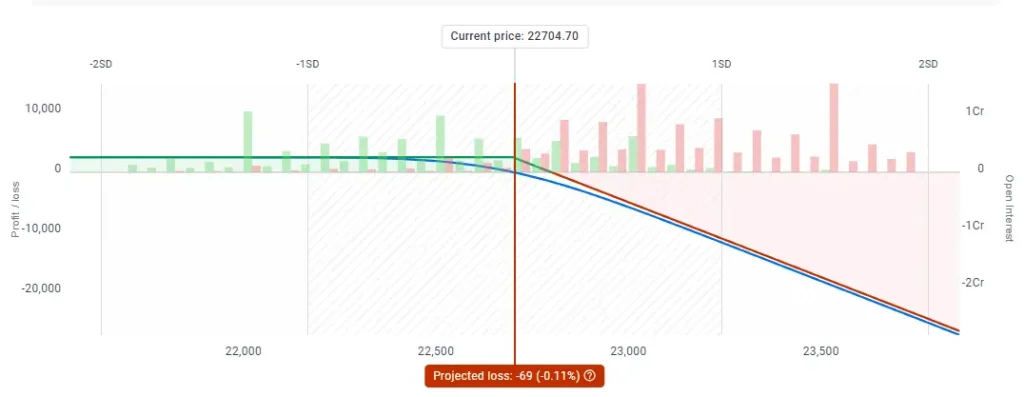
- The payoff chart for selling a call option indicates that the profit is limited to the premium received,
- The potential loss is unlimited, as it increases with the rise in the underlying asset’s price.
Remember that options trading involves risks, and there’s no guarantee of profits. Take your time to learn and practice, and gradually build your skills and confidence as a trader.
FAQs
A call option buyer profits when the underlying asset’s price rises. Conversely, a call option seller generates income by collecting premiums from the sale of these options contracts.
Yes, a call option buyer can sell the options contract to another option buyer at any time before the expiration date, at the prevailing market price of the contract.
The primary risk is losing the entire premium paid if the Underlying asset price does not exceed the strike price before expiration.
Selling call options can be profitable if the Underlying Asset Price drops, stays flat, or climbs only slightly. However, unlike the call buyer, you won’t be able to quadruple your money.
A call option is bought when we expect the price of the underlying asset to rise significantly before the expiration date of the option.



Leave a Reply